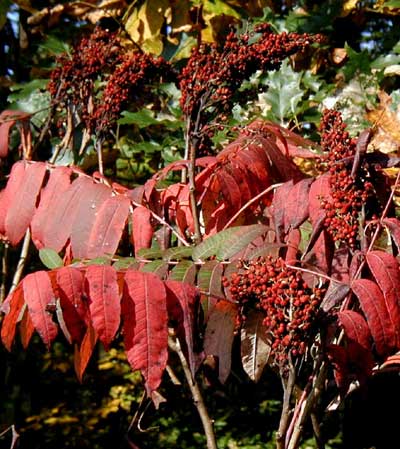Trees are changing colors. Maple leaves lighten their green and give way to yellows, oranges and bright reds that are some of the most vibrant colors of autumn. The yellows of the birches and ashes are followed by the oaks with their brown leaves that finish off the season.
The sun is low in the sky and shadows are getting longer now. In the summertime the sun seems to jump up into the sky, and now it just takes its time and struggles to reach the peak of the summer sun. Try taking photos of sun streaks through the tree leaves to see some interesting patterns.

Sun shining low in the sky produces a starburst effect when viewed through the trees.
Smooth Sumac, Rhus glabra, are small trees found at the edge of the corn field and along the lane. This time of year the berries are bright red and so are the compound leaves. Sumac berries are a good food source for many types of songbirds as well as the pheasant, turkey and grouse.

Red berries hide among the bright red leaves of the sumac tree.
Native Americans used sumac wood to make long peace pipes. The pith of a section of sumac wood can be picked, pushed or burned out to produce a hole than runs the length of the branch. The bowl and mouthpieces were inserted into the openings of the pipe and typically were removable for transport so as to protect each piece. Decorative carvings or paintings adorned the pipes.
Red sumac berries have been used to make a lemonade-like drink for many years. All you do is collect the group of berries and soak in cold water for about 15 minutes. Strain the pink liquid through cheesecloth, sweeten and chill.
You can use either staghorn sumac or smooth sumac berries as there are only slight morphological differences between these two Rhus species that sometimes hybridize.
Don’t worry, the red-berried sumacs are not like poison sumac, which has ivory-white berries that dangle downward and grows in swamp-like areas. Don’t touch any part of the poison sumac plant as it causes severe dermatitis – even worse than poison ivy!